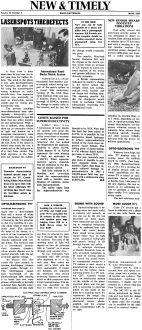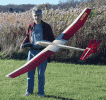|
March 1969 Radio-Electronics
 [Table of Contents] [Table of Contents]
Wax nostalgic about and learn from the history of early electronics.
See articles from Radio-Electronics,
published 1930-1988. All copyrights hereby acknowledged.
|
In 1969 when this news item
appeared in Radio-Electronics magazine, any temperature of
superconductivity
above absolute zero (0 K) was considered a major accomplishment. Dreamers dreamed
of room temperature (RT) superconductivity from the time it was first predicted
theoretically in 1911, but not even the people telling us we would be driving anti-gravity
cars by the turn of the century thought we'd get there anytime soon - and we didn't.
High temperature superconductivity is defined today as occurring at 77 K or
above. Some exotic compounds have exhibited superconductivity under extreme pressures
at temperatures as high as about 250 K (-23 °C, 10 °F). Unfortunately,
we are still nowhere near the point that practical industrial or commercial applications
are possible.
New & Timely: Limits Raised for Superconductivity
 Murray Hill, N.J. - Transmission of large
electrical currents over great distances through small-diameter cables came closer
to economic reality with a recent development that has pushed the temperature for
superconductivity to above 20.7°K. (Zero degrees K or Kelvin represents the
total absence of heat, an equivalent to -460°F.) When superconductivity occurs,
materials lose all resistance to the passage of electric current. Murray Hill, N.J. - Transmission of large
electrical currents over great distances through small-diameter cables came closer
to economic reality with a recent development that has pushed the temperature for
superconductivity to above 20.7°K. (Zero degrees K or Kelvin represents the
total absence of heat, an equivalent to -460°F.) When superconductivity occurs,
materials lose all resistance to the passage of electric current.
Bell Labs scientist B. T. Matthias and co-workers raised the superconductivity
level with a metallic combination of niobium, aluminum and germanium.
The earlier upper limit for superconductivity was
thought to be 18°K. Now that this limit has been raised to 20.7°K, it
is possible to use inexpensive liquid hydrogen to achieve superconductivity instead
of the much more expensive liquid helium. The boiling point of liquid helium is
4°K whereas liquid hydrogen boils at about 20°K.
The new materials may also make it possible to produce magnetic fields with densities
higher than those already achieved through superconductivity. In 1961 a 100,000-gauss
field was produced with a niobium-tin alloy at Bell Labs. R.E
Posted April 14, 2023
|










